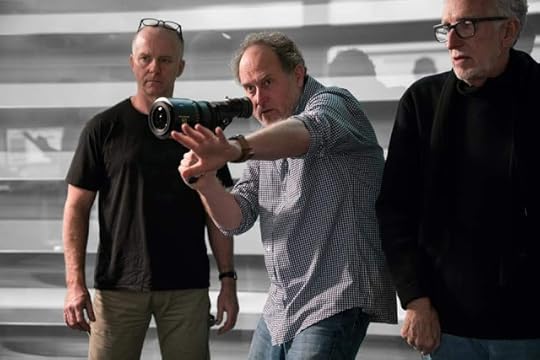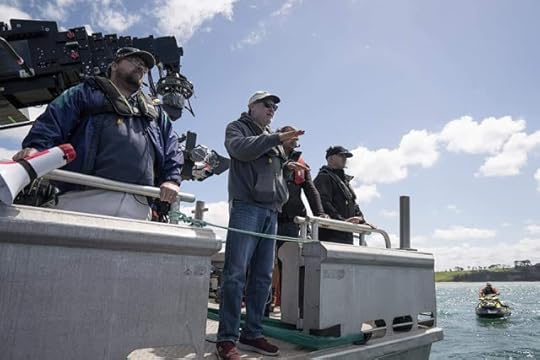Kenneth Atchity's Blog, page 114
August 8, 2018
The Meg Opens Wider in RealD 3D Theatres, Friday!
“Everything comes to life in RealD 3D. It really is a completely different experience.”
– Director, ~Jon Turteltaub
Witness the largest prehistoric shark in history.

– Director, ~Jon Turteltaub
Witness the largest prehistoric shark in history.

Published on August 08, 2018 07:40
August 5, 2018
INTERVIEW: Li Bingbing battles massive shark in new Hollywood movie The Meg

After battling zombies and giant robots in Hollywood blockbusters like Resident Evil: Retribution (2012) and Transformers: Age Of Extinction (2014), Chinese actress Li Bingbing, 45, now takes on a 75-foot-long shark known as the Megalodon alongside English actor Jason Statham in The Meg.
The sci-fi action thriller directed by Jon Turteltaub.
When a deep-sea submersible that is part of an international undersea observation programme is attacked by a creature and lies disabled at the bottom of the deepest part of the Pacific Ocean, a former deep-sea rescue diver (Statham) joins forces with the daughter (Li) of a visionary Chinese oceanographer to save the trapped crew.
What attracted you to The Meg?
It was a total challenge for me. It challenged my mind, my body and my fears...And I love the adrenaline rush. But the real reason is that I got the chance to pilot a glider for the first time.
The title creature is a mammoth prehistoric shark that threatens the crew aboard an oceanic research vessel.
How do you feel about sharks?
Sharks have lived on Earth over 500 million years. Before beginning work on The Meg, I thought that sharks ate humans. But I learnt that sharks eat only invertebrates and fish.
What kind of training did you do for the film?
I did a lot of research on shark habits. I also trained in scuba diving.
What was it like being in the water - or underwater - for such a long time?
Performing underwater wasn't easy. Sometimes, I had to hold my breath for a long time, which was hard. During a scene... I was wearing diving equipment inside a very small shark cage. The shark was attacking the cage and the cage kept moving. I almost ran out of oxygen. I was exhausted when I got out of the water.
What was it like working opposite Jason Statham?
Working with Jason was amazing and a lot of fun... Jason is very different from the characters he plays. When he smiled, I thought "Oh, he has the nicest teeth!" because I had never seen Jason smile in his films.
Later, I told him that I am not a native English speaker, so I needed to rehearse many times before we filmed our scenes. He was so sweet and supportive, and kept saying there was no way he could have done this film in Chinese.
Read more

Published on August 05, 2018 00:00
August 4, 2018
WFLA Interviews Sharon Farsijani Author of Shaming My Red Lips
Published on August 04, 2018 00:00
August 3, 2018
'The Meg' Director "Set Out to Make the Second Best Shark Movie of All Time"
 Turteltaub was photographed July 25 in his Malibu home office. Ahead of his first international co-production, set to hit theaters Aug. 10, Jon Turteltaub talks tackling the marine predator genre, working with China and why Jerry Bruckheimer said "undersea movies are boring and don't work." Director Jon Turteltaub knew he was gonna need a bigger shark. After all, if you're going to tackle the genre these days, you'd better bring something new to the table, since the undersea apex predator has been reimagined in countless forms, from flying sharks to robot sharks and, yes, even zombie sharks.
Turteltaub was photographed July 25 in his Malibu home office. Ahead of his first international co-production, set to hit theaters Aug. 10, Jon Turteltaub talks tackling the marine predator genre, working with China and why Jerry Bruckheimer said "undersea movies are boring and don't work." Director Jon Turteltaub knew he was gonna need a bigger shark. After all, if you're going to tackle the genre these days, you'd better bring something new to the table, since the undersea apex predator has been reimagined in countless forms, from flying sharks to robot sharks and, yes, even zombie sharks.So, for his waterborne action thriller The Meg, the 54-year-old director, whose career has bounced between smaller fare like 1993's Cool Runnings and big-budget studio spectacles like the National Treasure franchise, decided the best course of action was to go big — really big. Arriving in theaters Aug. 10 from Warner Bros., The Meg pits action star Jason Statham against a giant prehistoric shark called a megalodon. Lured to the project by producer Lorenzo di Bonaventura, Turteltaub finished principal photography in December 2016, with the film's hefty budget (studio insiders say $130 million, but sources peg it as high as $150 million) ensuring that the 90-foot-long beast didn't look, as he puts it, "really stupid."
The Meg also marks Turteltaub's first international co-production; the movie was co-financed and co-produced by Gravity Pictures, the film studio of entertainment conglomerate China Media Capital, which recently raised $1.5 billion. "A strong, healthy Chinese film industry is going to teach us more about China than CNN is," says the L.A. native. Set against the thematically appropriate backdrop of the Pacific, Turteltaub sat down with THR at the Malibu home he shares with his wife, producer and philanthropist Amy Eldon, and their three children, to discuss the anxieties of making a big-budget studio movie and the advice from Jerry Bruckheimer that he didn't heed.
 Eric Ryan AndersonA note from President Barack Obama to Turteltaub’s sons Jack, now 10, and Daniel, now 8. He also has a daughter, Arabella, 3.
Eric Ryan AndersonA note from President Barack Obama to Turteltaub’s sons Jack, now 10, and Daniel, now 8. He also has a daughter, Arabella, 3.  Eric Ryan AndersonTurteltaub and Eldon at their wedding. Eldon is co-founder of the nonprofit Creative Visions Foundation. How do you make a modern shark movie in Hollywood?
Eric Ryan AndersonTurteltaub and Eldon at their wedding. Eldon is co-founder of the nonprofit Creative Visions Foundation. How do you make a modern shark movie in Hollywood?I get asked the shark-movie question a lot. I'm not totally sure there is such a thing as a "shark movie." After Jaws, the shark movie became a thing, but it also became a pretty pointless thing compared to Jaws. So how do you exploit what Jaws got everyone interested in, knowing you'll never be that good? I remember when I was making Cool Runnings and someone saw an early cut and they said, "It's pretty good." And I said, "What do you mean pretty good? Isn't it awesome?" — as a joke. And they said, "Well, it's not like you set out to make the greatest movie ever." And I realized, yes, actually, I did. Every director on every movie sets out to make the greatest movie of all time. And along the way, you have realizations that that's not going to happen and you're just trying to make the best movie you can. I probably wanted to be a moviemaker because of Jaws, so truthfully, I set out to make the second best shark movie of all time. And I hope we did it.
What is it like making a blockbuster that isn't based on a well-known IP?
These days it's scary. My job is to just make that movie, but I'm fully aware that in the marketplace, in spite of the public complaining that everything is a sequel or a superhero, they're not living up to their complaints with the tickets they buy. It does give you plausible deniability for your lack of success. (Laughs.)
What did you take away from making a Chinese co-production?
When you enter the film business, it doesn't take long to realize that once a film starts shooting, it is a train wreck that you cannot stop. In development and in postproduction, you can maybe get more involved [as a financier]. And they did. That's normal. [But] in this case, it's hard to anticipate the needs because you don't know what their cinematic sensibility is and you don't know what their system requirements are. There's a lot to be said, written and studied about the Hollywood-China relationship that's probably best done in a book and not by somebody about to release a movie.
How have you seen studio franchise filmmaking change since the '90s and 2000s?
I've been through eras where the studios want to make as many movies as possible and as few movies as possible, as expensive as they can be and as inexpensive as they can be. If you look at an action film from 25 years ago, there were two action scenes, right? Now they have two nonaction scenes. The audience just wants more and more and more. They want lots of cool shit. [But] if [audiences] don't give a shit about the people in the movie and the characters, then they don't go. It's awesome to watch Iron Man blow shit up, but you go to see Tony Stark be the smartest guy in the room. That said, if the effects in a Marvel movie stunk, people would be pissed. So they didn't get any cheaper. On every single movie, either the visual effects house is getting ripped off or the studio's getting ripped off. [That's why] we have these companies going into and out of business. We haven't figured out how to make that system fair and consistent.
 Eric Ryan AndersonThis vintage elevator pointer hung outside his Disney office. “Everyone thought my door was the elevator and would stand there, waiting.” What's the "cool shit" in The Meg?
Eric Ryan AndersonThis vintage elevator pointer hung outside his Disney office. “Everyone thought my door was the elevator and would stand there, waiting.” What's the "cool shit" in The Meg?Because it's a first movie, not a sequel, you can't just throw money at stuff. You've got to be smart and pick your spots. And our spot we picked was the shark. Jerry Bruckheimer always warned me and said, "Undersea movies are boring and don't work." Because everything is slow and it doesn't feel real. And I realized how right he was when I suddenly found myself making a Jason Statham action film without gunfights, without fistfights and without car chases. What's left? There was a lot of pressure on us to show the shark early and often because today's audiences want to see it a lot. Here was the other big challenge: When you have a giant version of an animal, it immediately can look stupid and weird and "movie fake." But you can tolerate a lot more when it has a face. King Kong is a brilliant movie character because you spend the whole movie fearing him and the last 10 minutes in love with him. You cannot fall in love with a shark face. They have no eyebrows, they don't smile or frown, their eyes — you can never see the two eyes at the same time. It's just the antithesis of what humans have affection for. And that limits you as a director. I want people to fear the Meg, but I don't want them to hate it.
What would a National Treasure movie look like in today's political climate?
It is amazing how many people in Washington assumed I was a Republican because the movie is patriotic. I think today the movie would do just as well and is even more needed. The National Treasure movies stay away from politics, but they stay true to political idealism. And it bugged me that conservatives thought that these are only conservative ideas. The ideas in National Treasure are all of us, neither conservative nor liberal.
Do you think there is room for a third National Treasure movie?
Every person I know wants to make National Treasure III, with the exception of the people who are in charge at Disney. They don't feel it needs to be made. But Jerry and Nic [Cage] and I — Jon Voight and Helen Mirren and everybody else — we're ready to go.
 Eric Ryan AndersonA note from Last Vegas star Michael Douglas. “When you get a compliment from someone you idolize, it will be your best compliment,” says Turteltaub. How do you think the Disney-Fox deal and other studio mergers will affect filmmakers?
Eric Ryan AndersonA note from Last Vegas star Michael Douglas. “When you get a compliment from someone you idolize, it will be your best compliment,” says Turteltaub. How do you think the Disney-Fox deal and other studio mergers will affect filmmakers?Certainly the lack of variety of studios can easily make for a lack of variety of films. It's hard to say what's more significant, the fact that there aren't as many studios as there used to be, or the fact that one studio has six studios inside it. Disney's pulled these things together in a very smart way so that the people who are best at something focus on that thing. As a director, though, it might make the world a little cliquey. It gives you the advantage of being on the inside when you're on the inside, but it also puts you on the outside, and [it's] hard to break in. But I will say that with all the changes that have taken place over the years, it's hard to put your finger on anything that has made movies better or worse. Movies are either good or bad for their own reasons. Whether you're competing with TV, whether you're doing it with black and white or color, whether you're just making superheroes or just making romantic comedies, they find their way to suck all on their own.
Read more

Published on August 03, 2018 00:00
August 2, 2018
The Long Journey from Book to Film for Steve Alten’s Shark Thriller Meg

“The Meg” © Warner Bros. 2018
Peter Benchley’s 1974 novel Jaws did more than frighten and fascinate a generation of swimmers. It also inspired a young Steve Alten to research stories about great white sharks and their ancestors.
Alten’s take on the mother of all great whites — a prehistoric shark called a megalodon — comes to the big screen next month in “The Meg,” an adaptation of his 1997 novel MEG: A Novel of Deep Terror. Directed by Jon Turteltaub (the “National Treasure” films), “The Meg” stars Jason Statham (“The Fate of the Furious”) as U.S. Navy diver Jonas Taylor, who encounters a megalodon weighing about twenty tons in the deepest part of the Pacific Ocean. Ruby Rose (“John Wick: Chapter 2”) and Rainn Wilson (“Star Trek: Discovery”) costar.
The film’s advertising mixes plenty of teeth and the promise of terror with campy touches. Bobby Darin’s song “Beyond the Sea” plays in the trailer while swimmers and surfers flee. The posters feature taglines such as “Chomp on this” and “Pleased to eat you.”
For Alten, who turns fifty-fine in August, “The Meg” caps a long journey that began in the library when he was a Philadelphia teen, inspired by a love of Jaws. “I went straight to the library and checked out every true-life great white shark attack story,” he said in an interview earlier this year. “In the process, I came across little blurbs about megalodon, the prehistoric cousin of the great white, usually accompanied by a black-and-white photo of six scientists seated in a [megalodon] jaw.”
The megalodon grew to about 60 feet long and weighed up to 77 tons, according to the National Aquarium in Baltimore, which displays a massive replica of its jaw. People have recovered fossilized megalodon teeth that are as big as their hands at Sharktooth Hill in California, the aquarium says.
No wonder the meg never left Alten’s mind. He earned a master’s degree in sports medicine from the University of Delaware and a doctorate of education at Temple University, but as a married father of five, he struggled to make ends meet. In 1995, he saw an article in TIME magazine about deep water hydrothermal vents in the Mariana Trench in the Pacific and wondered “if that big shark was still alive down there.”
Alten returned to the library to research his idea, then wrote three to four pages a day from about 11 p.m. to 3 a.m. About six months later, the manuscript of MEG was born.
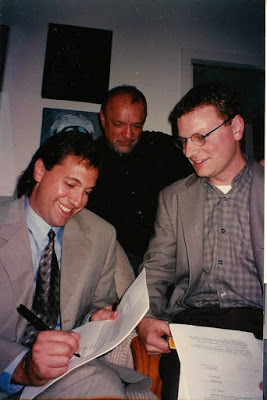 Alten, Ken Atchity, Joel McKuinFollowing a guide about how to get published, he sent out about seventy query letters to literary agents. Only one, Ken Atchity at AEI, liked the manuscript, and connected Alten with an editor for a rewrite. Writing a book, Atchity told him, “is like preparing a fish to cook — you cut off the head and tail and start with the meat in the middle.”
Alten, Ken Atchity, Joel McKuinFollowing a guide about how to get published, he sent out about seventy query letters to literary agents. Only one, Ken Atchity at AEI, liked the manuscript, and connected Alten with an editor for a rewrite. Writing a book, Atchity told him, “is like preparing a fish to cook — you cut off the head and tail and start with the meat in the middle.”The revision turned out to be fortuitous. Alten lost his job as a sales manager for a wholesale meat company, but MEG was published, even landing on the New York Times bestseller list.
Hollywood was interested, too, but changes in industry personnel among other issues meant a lot of stops and starts before the film finally came to fruition. In the meantime, Alten kept writing, producing six more books in the MEG series: The Trench, MEG: Primal Waters, MEG: Hell’s Aquarium, MEG: Origins, MEG: Nightstalkers, and MEG: Generations. His protagonist, Taylor, appears in all of them, sometimes with his older children — and the offspring of the prehistoric shark.
He’s also written about a dozen other books in the science- and speculative fiction genre, including Domain, Goliath, The Loch, The Omega Project, and Undisclosed. In addition, Alten launched Adopt-An-Author, a nationwide nonprofit program that provides books and materials for teachers to encourage reluctant teens to read.
Although some “MEGheads” (his loyal fan base) balked at images in the initial trailer — the shark not being albino, for instance — Alten is happy with the end result. He’s lived with Parkinson’s disease since 2006 and said in an open letter to fans online that he’s honored a studio wanted to buy his work. He’s also thankful to everyone over the years who has kept “this dream and career alive. …. what would I do without you?”
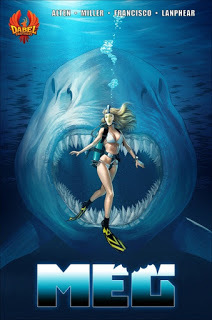
In honor of the film, MEG will be released in August as a graphic novel adapted by J.S. Earls and artist Mike S. Miller (The Hedge Knight, Injustice).
Read more

Published on August 02, 2018 00:00
August 1, 2018
Head Wounds | Dennis Palumbo with Barry Kibrick
Acclaimed author and psychologist Dennis Palumbo discusses his latest book, Head Wounds. This is the fifth installment of the much-admired Daniel Rinaldi Mysteries. In our conversation Dennis gets his most personal and all will benefit from his insightful wisdom that transcends the fictional.
For more Barry Kibrick go to: www.barrykibrick.com https://twitter.com/barrykibrick

Published on August 01, 2018 00:00
The Meg: Behind the Scenes
Published on August 01, 2018 00:00
July 30, 2018
Jason Statham Goes Deep About The Meg with Total Film!

With the summer movie season in full swing, The Meg is about to arrive with the aim of taking a chomp out of the competition. With a high-concept premise that can be most simply summed up as Jason Statham Vs a giant prehistoric shark (or “Jurassic Shark” as Statham himself puts it), it offers the promise of the kind of knowingly OTT blockbuster we see all too rarely these days.
Statham stars as Jonas Taylor, a diver who has had a previous run-in with the toothy beast of the title. The Meg – or Megalodon, to give it its full name – is a supersized shark that has emerged from the deep with an appetite, so it’s down to Jonas and crew to put a stop to the monster’s feeding frenzy.
You can take a look at Statham heading underwater in this exclusive image, courtesy of our sister publication Total Film magazine, which sees Jonas going below the surface with another crew member on the look out for the Meg.
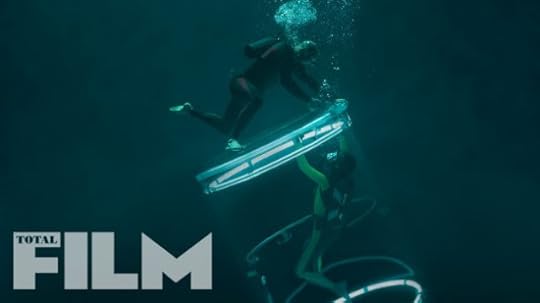
Jason Statham goes underwater in The Meg
Directed by Jon Turteltaub (National Treasure), The Meg is aiming to deliver suspenseful set pieces and monster-movie thrills, but it’s also going to have fun with the formula, while trying not to veer into Sharknado territory. “This is a much more legit, holy-crap-that’s-a-big-shark movie,” says the director. It’s based on really good science and really good filmmaking. We’re not making fun of shark movies, we’re celebrating them.
“It is, first and foremost, a big, scary, monster movie,” he adds. “But I kept saying, instead of running from the cliches, let’s lean into them. That helps with the humour. These characters will have seen Jaws… But that’s not the same as making a movie campy or satirical.”

As star Statham explains to TF, “It’s Jurassic Park meets Jaws. Everyone likes to say, ‘Jurassic Shark’. If you look at the poster, look at the creature, you know what you’re going to spend your money on. This is a film where people can sit down and get the popcorn out.”
For much more on The Meg and bunch more upcoming monster movies, you can pick up this month’s Total Film magazine, which hits shelves this Friday, July 27. Better yet, why not subscribe so that you never miss an issue?
That way, you’ll bag an exclusive, not-available-in-stores subscriber’s cover (as seen below), and My Favourite Magazines will deliver each new issue through your letterbox every month *and* save you money on the cover price. And if that’s not tempting enough, we’re currently running a promotion where new UK subscribers will get two Jurassic World Funko Pop! Vinyl figures when they sign up. What are you waiting for?
Read more

Published on July 30, 2018 00:00
July 28, 2018
More Awesome Image From September's Harper's Bazaar China featuring Jason Statham and Li BingBing
Published on July 28, 2018 00:00




